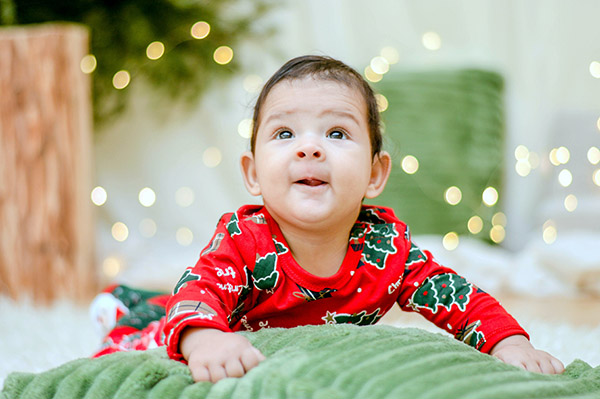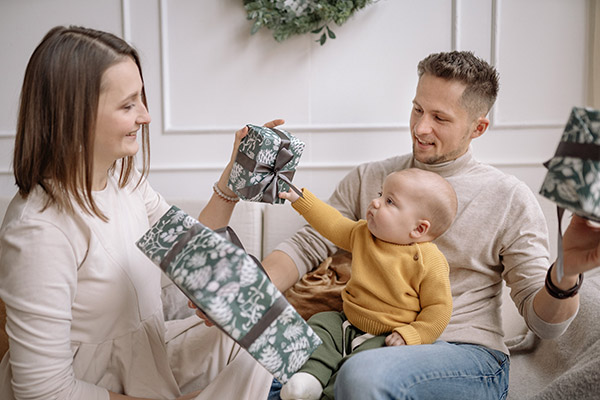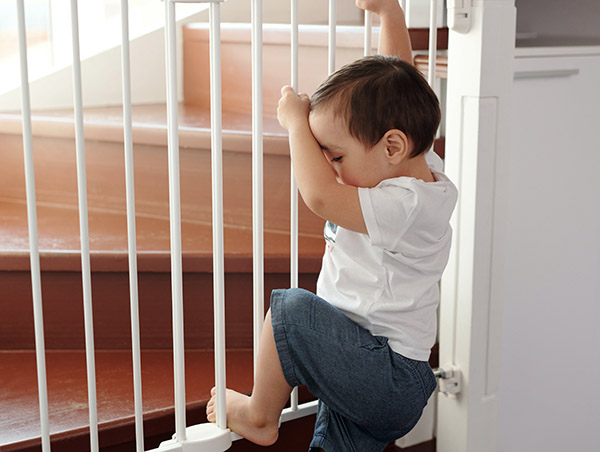Your Guide to Holiday Babyproofing
By Kristy Warren
As children grow, their curiosity and ability to explore grows, too—and during the holiday season, homes are full of new childproofing challenges: additional company, decorations, food, toys, and visiting new places. With so many opportunities to get into trouble, trying to think through every potential hazard can seem daunting. Here is an easy babyproofing checklist to help your family get started and enjoy a safe holiday celebration!
Crib Safety: Let's begin with where baby starts and ends the day: the crib. While you may wish to decorate your nursery for the holidays, remember to follow the ABCs of safe sleep: baby sleeps Alone on their Back in the Crib. Avoid using pillows, bumpers, blankets, or stuffed animals in the crib. Instead use a cozy sleep sack designed to keep baby comfortable in wintry weather.
Changing Diapers Safely When Traveling & Visiting Company: Babies learn to turn over quickly, and if they attempt to roll while being changed, they can fall. Baby changing stations often have built-in safety straps to allow you to buckle your child in while changing their diaper, but during the holidays, you may be visiting company without a changing station. To avoid injury, have all the items you need laid out close at hand before beginning the diaper change. That way, you never have to turn your back and can safely hold your baby in place throughout the change.
See Things from Their POV
Time flies when you're having fun, and you’ll be surprised how soon your baby is able to grab for things and on the move. Putting yourself in your child's shoes can give you a better idea of what needs to be baby proofed.
Get down on your hands and knees to survey your home from baby’s point of view. What can you reach? What catches your eye?
Pay special attention to cords, outlets, tippable furniture, candles, water sources, fireplaces, and decorations.

Keep it Covered: Use outlet covers to prevent electric shocks to curious fingers. Opt for babyproof outlet covers that require both hands or unscrewing to successfully remove, so that baby can’t tug them free. Where possible, consider moving furniture in front of outlets for extra protection.
Don't Get Burned: Dancing flames and twinkling lights can draw the twinkle in your eye into harm's way. Keep Christmas lights, menorahs, and kinaras well out of reach by placing them in an area where baby can’t crawl. Make sure that candles, light strands, and fireplaces are inaccessible through careful placement and fire grates to avoid burns, entanglement, and other injuries. Remember, even when being safely held, a baby or toddler may make a sudden grab for something that captures their attention, so stay alert for hazards.
Tie it Down: Securely tie down holiday decorations, Christmas trees, furniture, and electronics. Lock up toilet lids, cabinets, and drawers from prying fingers using childproof latches. Tie blinds, lights, and curtain cords well out of baby’s reach, or install breakaway safety tassels.

The holidays are packed with exciting new sights, sounds, and smells that can captivate your baby's attentionand stimulate their senses.
Whether they're crawling or being carried, babies may be tempted to grab for brightly colored ribbons, delicate ornaments, lights, flame, or food they cannot have.
Identify and Remove Choking Hazards: From tinsel and ornaments to tasty treats like nuts, hard candies, and popcorn, the holidays present many choking hazards. Even older children can be at risk, especially if eating while running and playing with family or friends. Supervise kids around food, encourage them to eat slowly, and separate eating time from reindeer games. Ensure your family and friends know how to properly render first aid to a choking child.
Be Upfront about Allergies: If anyone has allergies, encourage your child to always check in before eating something and make sure everyone in attendance knows what their allergies are and what to do in case of emergency. Bring allergy medication and an up-to-date epi-pen with you if appropriate. It's a good idea to double check any pre-packaged or readymade foods for potential allergen exposure. Even if your child doesn't have known allergies, pay close attention if your child is trying a new food for the first time. Stay alert for any signs of allergic reaction such as itchy eyes, swelling, sneezing, hives, rashes, stomach pain, or trouble breathing.
Keep Everyone in the Know
Involve the whole family: The holidays are a time for gathering. If baby will be spending time with relatives, family friends, or babysitters, ensure they all understand how your babyproofing measures work and why it’s so important to follow them, especially keeping inappropriate toys or decorations out of baby’s reach and refastening baby-proof latches, covers, ties, and gates after accessing an off-limits item or area.
Play Gatekeeper: If you can’t babyproof every room in your home, block your baby’s access using baby gates. Be sure to block staircases, ramps, and sharp drops.
Be aware that as your child keeps growing, they can eventually scale or open these gates, so update your babyproofing as baby reaches new milestones like crawling and walking.

Watch Windows: Sometimes we need a little fresh air in a stuffy room, especially in the middle of our holiday party, but be extra careful to note if a window does not have a screen. Don’t rely on regular window screens to support baby’s weight either. Look for window safety guards and screens labeled “babyproof” or “childproof” to prevent falls.
Mind Your Medications: With extended family visiting, baby has new access to purses and toiletry bags with pillboxes. Keep all prescriptions, vitamins, and supplements in upper, locked cabinets and dispose of expired or unwanted medications using a drug deactivation pouch or a drug takeback box, never the trash or toilet.
Playtime Safety: ‘Tis the season of giving but purchase age-appropriate toys that cannot be swallowed, easily damaged, or pulled apart. Don’t let your baby play with their older relatives’ toys unsupervised. Toys' suggested age ranges help ensure who's old enough to play with it safely and that it meets your child’s current developmental needs (e.g., a material that's appropriate for teething babies).

Toy Upkeep: Regularly inspect toys for any damage or loose parts. If you are using a toy box to keep the playroom clean, choose one with a lightweight lid that slides or pops off. This will keep the lid from unexpectedly slamming down, trapping, or pinching your child.
For more information on health and safety tips for the whole family, stay tuned to Laurel Health's wellness blog or visit us on Facebook at facebook.com/laurelhc.
